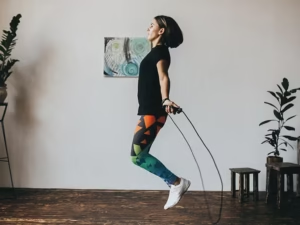In 2025, it’s easier than ever to start exercising because there are so many at-home workouts to choose from. Whether you’re new to exercise or returning to it after a break, starting a home exercise program could be life-changing. It’s easy to use, inexpensive, and adaptable, allowing you to fit exercise into your busy life. In this guide, we’ll discuss everything you need to know as a fitness novice, and how to create a good at-home exercise program.
Learn the basics of exercise
Before you start any specific exercise program, it’s important to understand the basics of exercise. Fitness is all about making your body healthier, which means getting stronger, more durable, more flexible, and just generally better. Regular exercise helps your heart health, speeds up your metabolism, and reduces your risk of long-term conditions like diabetes, heart disease, and obesity.
Cardiorespiratory fitness, strength training, movement and flexibility, and balance and coordination are the four key parts of fitness.
Exercises that increase your heart rate, such as running, cycling, and jumping rope, are good for cardiovascular health. They’re good for your heart and help you exercise longer. Strength training builds muscle and makes you stronger. You can use dumbbells, resistance bands, or your own body weight. Exercises that improve flexibility and mobility, such as yoga and stretching, are good for your joints. Balance and coordination exercises can improve your stability, helping you avoid falls and stand up straighter.
Set of Fitness Goals
Before you start any exercise program, it’s crucial to set achievable fitness goals. Your exercise style and motivation will depend on your goals. Think about what you want to achieve, whether it’s losing weight, building muscle, improving flexibility, or just getting healthier.
When setting goals, remember the SMART principle: goals should be clear, measurable, achievable, relevant, and have a deadline. For example, you might say “I want to lose weight,” but your goal could also be “I want to lose 10 pounds in three months by exercising three times a week and improving my eating habits.”
Create a Home Exercise Plan
A good workout at home doesn’t require expensive equipment or hours of work. In fact, some exercises you can do on your own can be very beneficial for strengthening your physique and building muscle. Here’s how to create a home exercise plan:
Start with a full-body workout.
A full-body workout is the best way to build a lot of muscle at once when you’re just starting out. Working out your entire body can make you stronger and last longer overall, and it can burn more calories than working just a few muscles at a time. Push-ups, squats, lunges, planks, and hip bridges are simple exercises that you can use to work your entire body. A good place to start is with three sets of 10 to 15 reps of each exercise.
Gradually increase the difficulty.
If you want to get stronger and last longer, you can increase the intensity of your training. You can increase the reps, the duration of each exercise, or the number of sets. You can also add different types of exercises to make your training more difficult. You can do incline or decline push-ups instead of regular push-ups, or add resistance bands to your squats to make it more difficult.
Work out your core.
To maintain good balance, support, and avoid injury, you need a strong core. Do exercises that work your core, such as planks, Russian twists, leg raises, and bicycle crunches. You can also work your abdominal muscles by doing three to four sets of two to three exercises.
Aerobic exercise can help you lose fat and build endurance. Aerobic exercise is important for improving heart health, burning fat, and building endurance. Strength training is just as important. You don’t need any special tools or a lot of space to do these activities. Jumping jacks, high leg raises, burpees, mountain climbers, and (if space allows) jumping rope are all great exercises to do at home. Start with 10 to 15 minutes of light exercise and gradually increase your workouts as your fitness level improves.
Flexibility and agility exercises
Flexibility and agility are often overlooked, but they are essential to a well-rounded fitness program. Incorporating stretching and flexibility exercises can improve muscle elasticity, joint health, and overall recovery.
Include stretches such as forward bends (hamstring stretches), quadriceps stretches, shoulder stretches, child’s pose (yoga stretches), and hip openers. Short yoga sessions are a great way to improve flexibility, promote muscle healing, and calm the mind.
Keep it up
As with any exercise routine, consistency is the key to success. Start with two to three sessions per week. As you get more comfortable, you can slowly increase the number of sessions. The more often you exercise, the faster your strength, endurance, and overall health will improve.
Record
Monitor your progress and enjoy small victories to keep you going. This could be adding more reps, using heavier weights, or getting better at exercises.
Don’t forget to rest and heal.
You need to rest and recover as much as you train. Overtraining can be detrimental and tiring. Take at least one or two days off each week so your muscles have time to heal and grow back. On days when you should be resting, do light activities like walking or stretching.
Sleep is also very important for healing. Getting 7-9 hours of good sleep each night helps your body heal and recover.
Finally
Getting fit doesn’t have to be hard or expensive. To build a strong and long-lasting home workout program, set reasonable goals, emphasize total-body workouts, add cardio and flexibility exercises, and stick to them. Remember that growth takes time. Be kind to yourself and enjoy the ride. By 2025, you can achieve your training goals from the comfort of your own home if you put your mind to it and work hard.



